Empty space has more energy than everything in the Universe, combined
When all the galaxies, stars, gas, dust, dark matter and all the other forms of matter and radiation are summed together, its energy still pales in comparison to dark energy. So what’s going on with our Universe?
“Nothing exists except atoms and empty space; everything else is just opinion.” –Democritus of Abdera
When you take a look out at the Universe, past the objects in our own solar system, beyond the stars, dust and nebulae within our own galaxy, and out into the void of intergalactic space, what is it that you see?
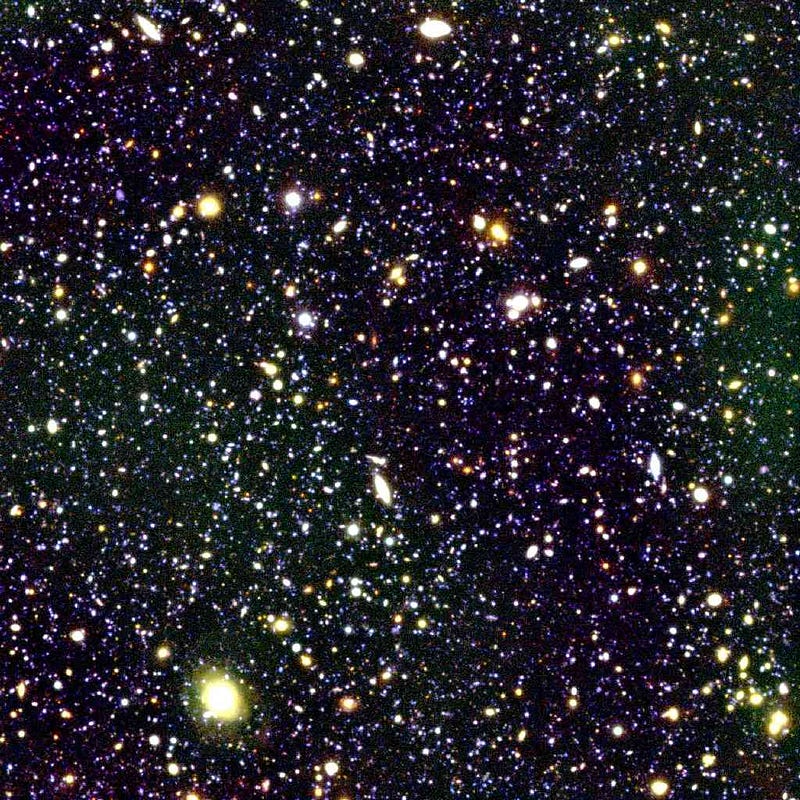
Yes, there’s a plethora of wonderful things within our own galaxy, but we’re just one of at least 200 billion out there, strewn across a spherical region (visible to us) some 92 billion light-years in diameter.
What we normally think of as the entire observable Universe consists of these hundreds of billions of galaxies, with about 8,700 identified in the tiny patch of deep-sky shown above. Each one of those galaxies, itself, contains hundreds of billions of stars, just like our own Milky Way, and this is just counting the part of the Universe that’s presently observable to us, which is by no means the entire thing!
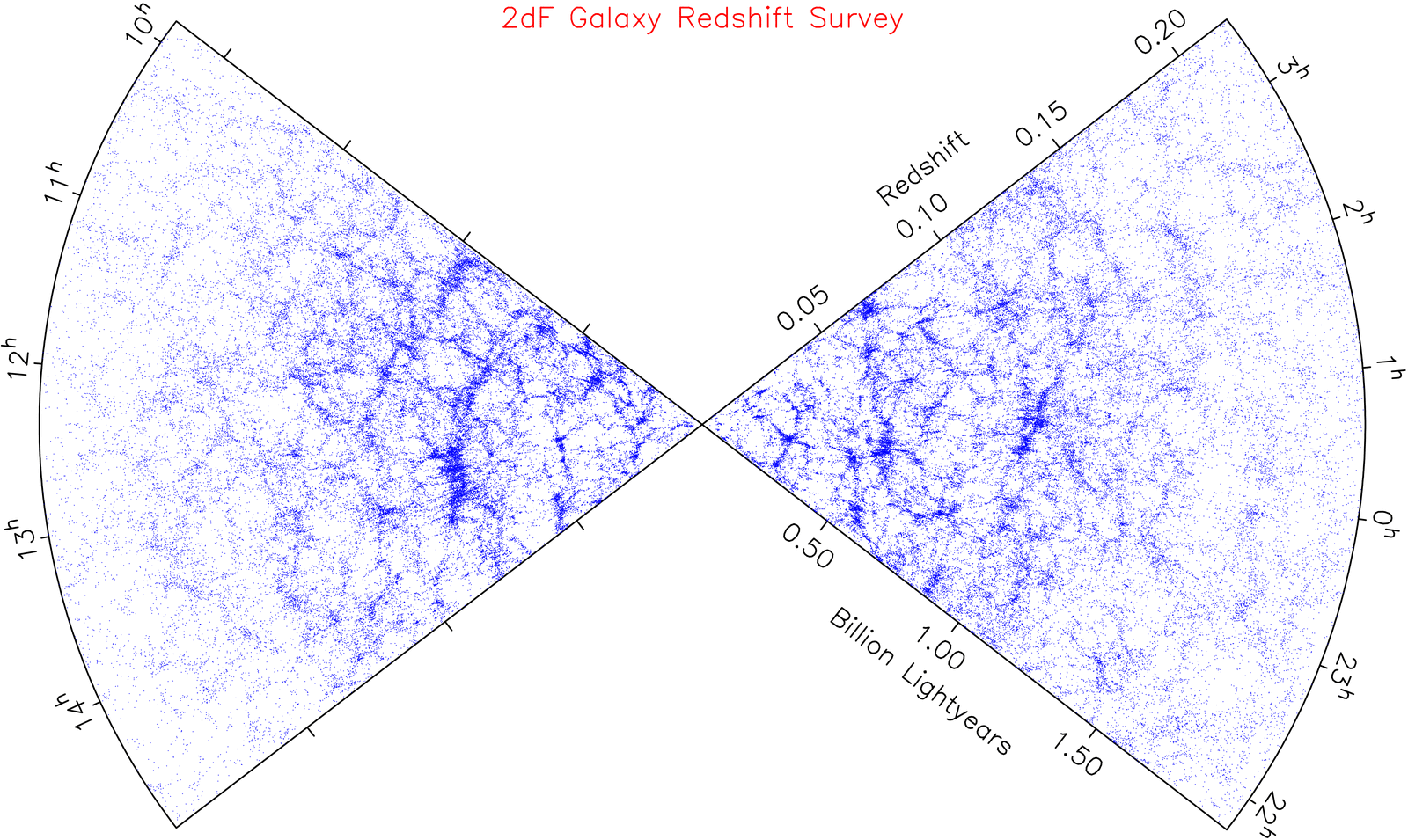
And yet, if we map out everything known in the Universe, and trace out the cosmic structure, we find that the normal matter — things made out of all the known elementary particles — is less than 5% of the total energy density of the Universe. There’s got to be about 20-25% of the Universe in the form of dark matter, a type of clumpy, collisionless matter that is made up of a yet-undiscovered particle, in order to get the type of clustering we see.
But perhaps most bizarrely, the remaining energy of the Universe, the stuff that’s required to bring us up to 100%, is energy that appears to be intrinsic to empty space itself: dark energy.
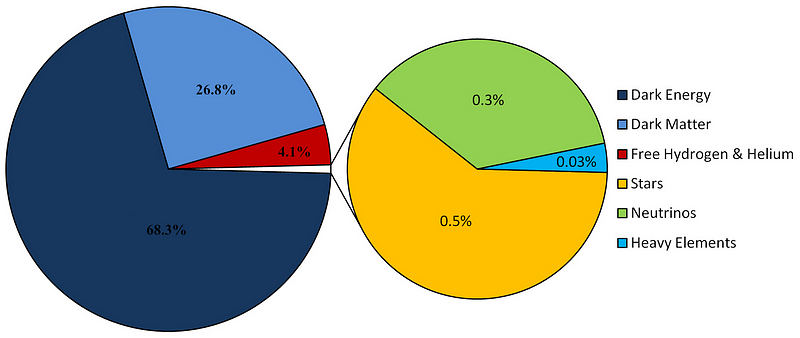
A little over a year ago, Matt Francis ran a Carnival of Cosmology on Dark Energy, and — as they often do — the questions for cosmologists everywhere poured in. So what is it that you wanted to know about this more-than-two-thirds of all the energy in the Universe?
Let’s see what we can learn!
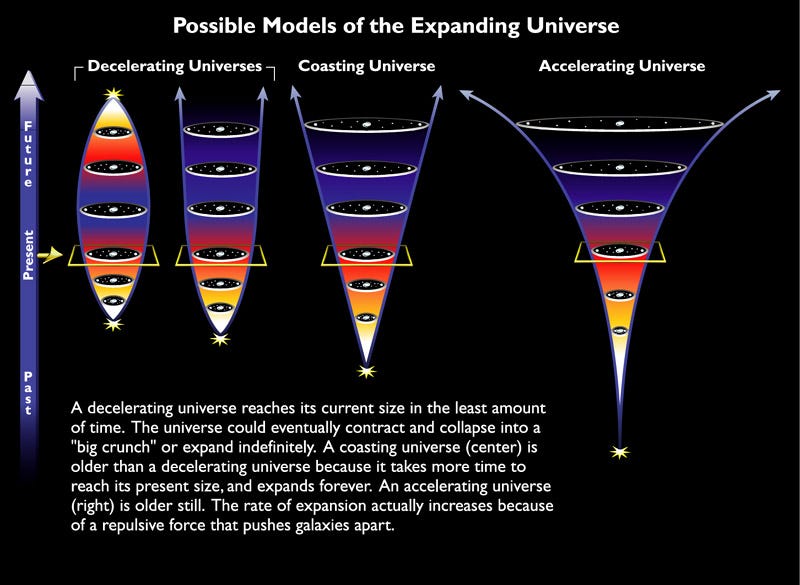
“Where is the dark energy coming from in an expanding universe? It seems to violate the laws of energy conservation.” –Richard Latham
This question is a good one: if there’s an intrinsic energy to space, and it’s expanding (and therefore creating more space), aren’t we violating the conservation of energy? It seems like we might be, like we’re just creating energy where there was none before.
But would that mean that energy also isn’t conserved in an expanding Universe with radiation in it?
After all, it isn’t just the case that the radiation dilutes in density as the Universe’s volume increases; the radiation also becomes lower in energy as the expansion of the Universe stretches its wavelength.
This would be your instinct, and I can’t blame you for having it. But General Relativity is a little more subtle than that. The answer is no in both cases. Dark energy doesn’t only have an energy density: it also has a negative pressure with very specific properties, and radiation not only has an energy density, but a positive pressure with specific properties of its own. As the pressure from your energy source pushes outwards (for dark energy; inwards for the positive pressure of radiation) on space, it does negative work (positive work for radiation) on the Universe. The work it does is exactly equal to the change in mass/energy of whatever patch of space you’re looking at. So as long as you take this definition of work into account in your Universe, you can define energy in such a way that it’s conserved.
(I wrote a more technical explanation on the old blog, for those so inclined.)
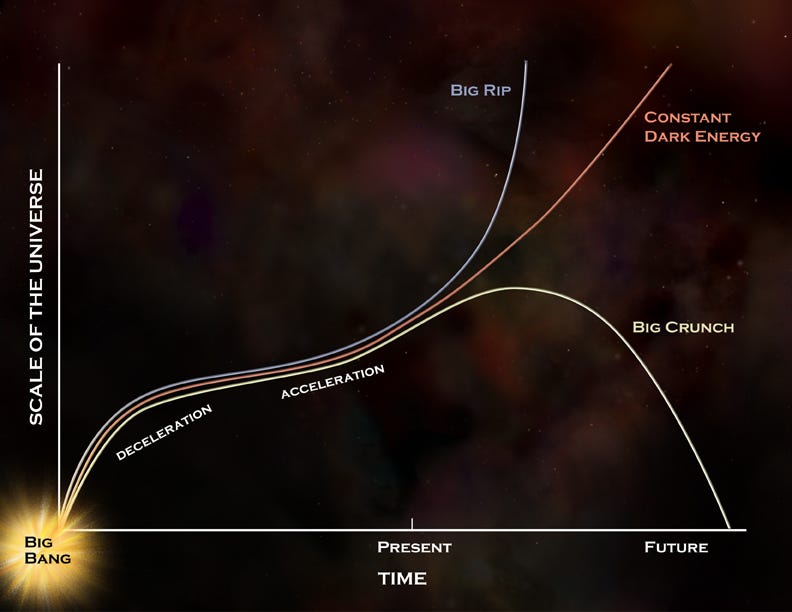
“In articles about the nature of dark energy, I frequently see “quintessence” mentioned as one possibility. I’ve never seen any explanation of what that would be. In my present state of knowledge, the word might as well be “magic”. Assuming it is legit (i.e. not a handwave or ether redux) can you give us some idea of what it is?” –anatman
Let’s back up a little bit and explain “dark energy” first. When physicists say “dark energy,” we mean that we observe a uniform accelerated expansion to the Universe, and in physical cosmology the thing that causes that is a uniform energy density with a sufficiently negative pressure.
The simplest model that best fits the data is to have dark energy be what Einstein called a cosmological constant, where pressure exactly equals the negative of energy density times the speed-of-light squared [ P = – ρ c^2 ]. That’s 100% consistent with the best data we have today from all sources. But it could be something more complicated: dark energy could be time dependent, it could have the pressure not satisfy the above equation exactly, it could have a constant multiplying this (currently constrained to be between about 0.88 and 1.12), etc. In general, it could behave in any way other than this that you can imagine. A large class of the models we can imagine (parametrized by a scalar field, if you care for that detail) are known as quintessence.
They may be fun (for some) toys to play with, but there is so far no evidence to indicate that dark energy requires any more complexity than the simplest and most natural explanation: a cosmological constant.
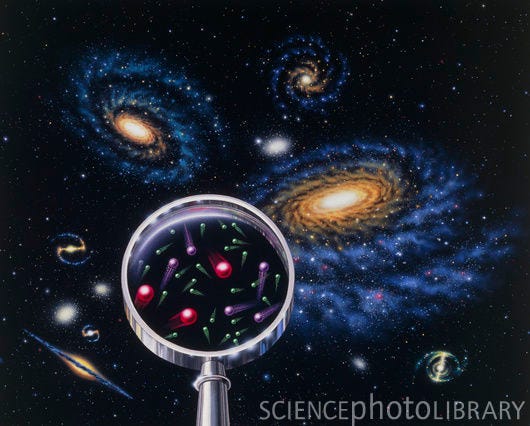
“In your opinion, what length of timeframes and advances in technology do you relatively think it’ll take to understand dark energy beyond just observing its effect on the expansion of the universe?” –James G.
“Is there a known (or suspected by a theory) connection between dark energy and fundamental particles?” –Erol Can Akbaba
“Is there any plausible experimental handle on dark energy? Any reasonable way, either on the ground, or at least on Solar-system scales, to directly interact with whatever it is?” –Michael Kelsey
The answer to these questions is completely dependent on whether dark energy is fundamentally related to a particle or not. If it is, then all it will take is a powerful enough collider to create that particle, and a way to distinguish the “missing energy” that comes out from things like neutrinos.
But most models of dark energy — including the cosmological constant model — don’t have a particle associated with it. If dark energy doesn’t have a particle associated with the field driving it, our prospects are much more pessimistic. Remember that most models of dark energy (the ones that aren’t ruled out by observations, at any rate) don’t have it clump, cluster, or interact with anything other than the expansion of space. Which is to say, I can’t even imagine how to do find out more about dark energy directly under those circumstances, given the physics that wecurrently know.
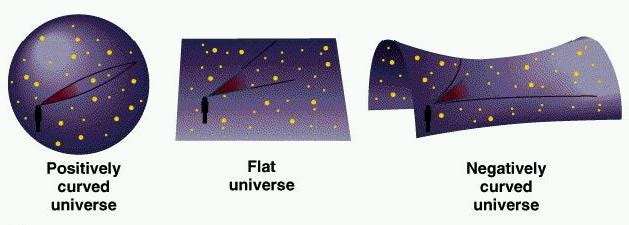
“How does the earlier post about a Universe being so flat flat flat that there could be trillions of years of expansion enter into this?” -Dave Dell
Curvature and energy density are very closely related in cosmology: you measure the expansion rate (which allows you to calculate the Universe’s critical density), you measure the energy density from all the different forms of energy, and then you compare those two to determine the curvature. As far as our measurements can tell, the actual average energy density of the Universe — including dark energy — is indistinguishable from the critical density, and that’s why our Universe’s curvature is indistinguishable from flat.
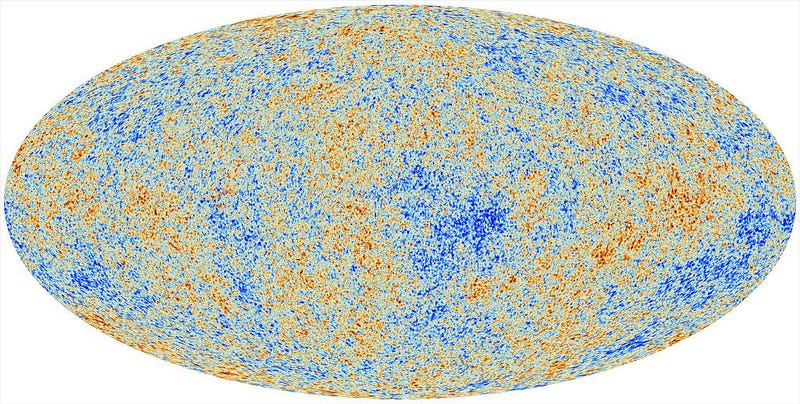
“Could Dark Energy be the final stage of light? I learned in High School (provided my memory serves me right) that as light travels and expands it moves further along the spectrum and that the Universe is filled with Cosmic Microwave Background Radiation. Could Dark Energy be that radiation?” –Jordan Brooke
I wish that were possible. Radiation — in this case, in the form of photons — is generically a massless particle that moves at the speed of light. Unfortunately, it’s incredibly well understood, it does contribute to the expansion rate of the Universe, but it slows the expansion down, and has a positive, not a negative pressure. This applies to all forms of radiation as well, including any massless particles traveling at the speed of light as well as massive particles that move very close to it. So while it does exist and does contribute to the expansion rate, it is not the cause of dark energy. If you wanted it in more technical terms, for radiation, P = +1/3 ρ c^2.
On the other hand, dark energy actually causes the radiation to redshift faster than it would in a Universe without dark energy. So in our Universe, the presence of dark energy actually makes the cosmic microwave background radiation slightly less important to the fate of the Universe than a Universe without it!

“The reason I have a hard time accepting Dark Energy is because I have no idea what I’m even supposed to be thinking of. As anatman said, it seems like so much “Abra Kadabra!” and poof, an F appears on my physics test.”
–Donovan, seconded by Jeff
I once had a (very cranky) physicist describe dark energy as
“The biggest F U the Universe could have possibly given us.”
While I don’t quite agree, I do sympathize with that point of view. Perhaps the best way to relate to it is to think of it as a fluid that permeates all of space at all times. As the Universe expands, creating more space, the new space has the same properties as the old. In the phrase “cosmological constant,” the constant part refers to the energy density, or the fact that unlike particles of matter and radiation, dark energy doesn’t dilute as the Universe evolves. It’s a property intrinsic to space itself, and as far as why goes, we’re not sure. That may be dissatisfying, but it’s what the math and physics tell us, and at this point, that’s the best I’ve got.

“Why is it called, dark ‘energy’?” –Jeffrey Boser
The energy part doesn’t bother me nearly as much as the “dark” part does. The energy part is because it’s an intrinsic energy to space — the zero-point energy — that actually has a positive, non-zero value. I would prefer to call it “vacuum energy” because it’s the energy intrinsic to empty space, or perhaps the quantum vacuum. But this dude said “dark energy” before anyone knew who I was, because it seemed to go along nicely with our concept of “dark matter.” Now everyone calls it that, and most of us hate the name, too. There’s your bummer of an answer.
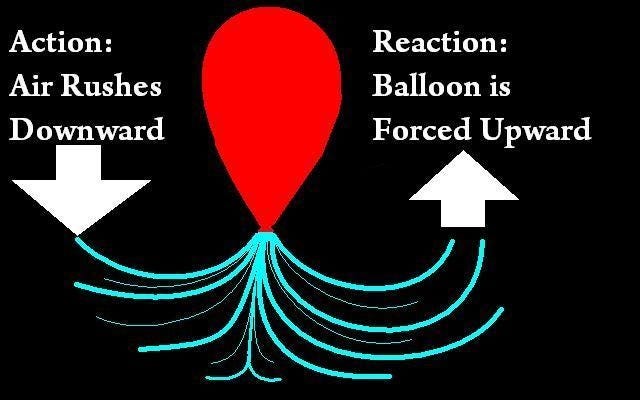
“If the Universe is accelerating, where is the equal and opposite reaction?”
–Bobby van Deusen, for his 14-year-old son, Jack
The answer, believe it or not, is the “dark energy” itself! Remember that the accelerated expansion isn’t the same as dark energy; one is a phenomenon and the other is a form of energy. The accelerated expansion of the Universe is the reaction, and dark energy is the thing that causes it, the thing that does the work on our spacetime, and is itself the action. If the Universe either had dark energy and no acceleration, or had acceleration with no dark energy, then we’d have a problem. But we have one because we have the other, and in fact that’s how we know we have dark energy.
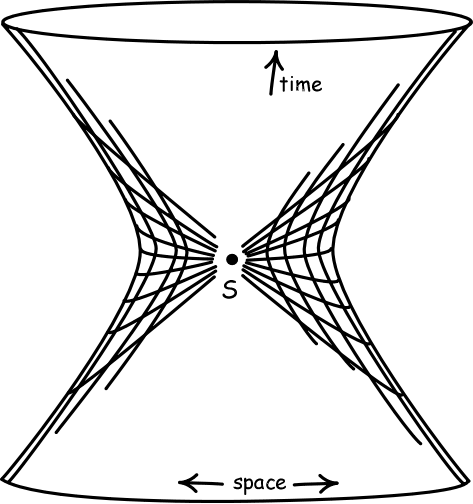
“Is Dark Energy a fundamental force of nature?” –Jon
As far as we can tell, it is not a separate force the way electromagnetism, the weak force, or the strong force is. It is part of the force of gravity, and was even predicted by General Relativity originally. Gravity could have existed with any value for a cosmological constant — including zero — but our Universe appears to have the one particular value that it does. As to why it has that value… well, figure that out, and the Nobel Prize in Physics is yours! Regardless, it isn’t an extra force, just one aspect of General Relativity that happens to have the specific properties that it does.
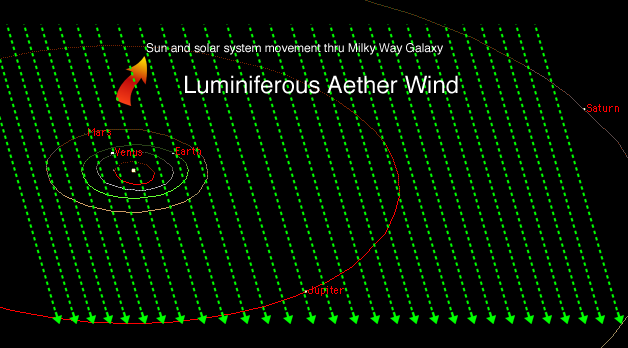
“Sounds like ether to me.” -Alan
The big difference, remember, was that long-ago hypothesized aether was a thing that light needed to travel through. It was a medium, a physical substance that would be dragged and modified relative to a universal rest frame. As light traveled through it, dependent on its direction and orientation, the aether would affect it in different ways.
With the exception of the expansion rate of the Universe, nothing we can measure would be any different if it weren’t for dark energy. Not light, not gravitational waves, not the motions of the planets or stars. While dark energy appears to have one thing in common with the old luminiferous aether — it permeates all of space, uniformly, everywhere — it neither has a preferred reference frame nor is it required as a medium for anything to travel through.
At least, as far as we’ve been able to observe to date.
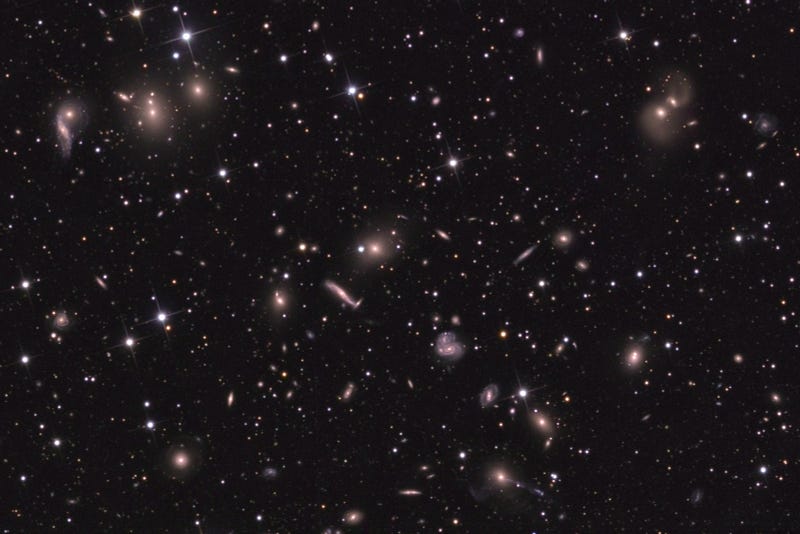
“Is this new dark energy being created that is strong enough to overcome gravity attraction between galaxies?” –BillK
We live, right now, in either a very interesting or a very disgusting time, depending on your point of view. On one hand, gravity is still working in full-swing, and all masses are gravitationally attracted to all other masses in the Universe. On the other, there is this intrinsic dark energy “pushing” things that are expanding away from one another to accelerate away from one another even faster.
At this point in time, everything that is already gravitationally bound to one another — including us and our local group, and all the individual galaxies in a large cluster (like Hercules, above) — will stay that way; dark energy will lose to gravitation on those scales. But on larger scales, those groups and clusters that are not already bound to one another never will become so, and will accelerate away from one another as the Universe continues to expand. In our neck of the woods, that means the local supercluster — the Virgo supercluster, of which we are a part — is not a single, gravitationally bound entity, and we will never fall into the Virgo cluster of galaxies, nor will many of the other larger, closer groups. The one group that might stand a chance of being bound to us is the M81 group — home to the closest supernova to us in a generation — although it’s going to be very close, and the answer is still “probably not.”
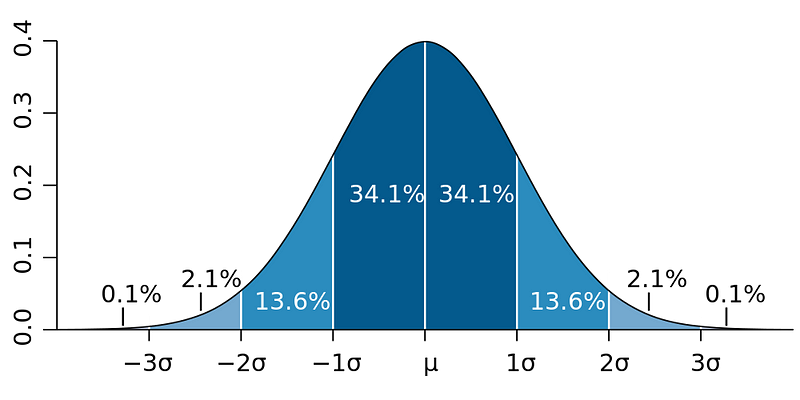
“My question is basically why the need for DE? The whole universe can still be homogeneus and isotropic on the largest scale but have fluctuations on small scales.” –Sinisa Lazarek
If what we observed as “dark energy” were just a fluctuation — a result of our observable Universe being a different density than most of the Universe — we would be about a 10,000-sigma fluctuation away from what we’d normally expect. The probability of that happening is about the same as your odds of playing “1, 2, 3, 4, 5, 6″ and winning the lottery every week in a row for your entire life.
In other words, it’s unlikely enough that we don’t even consider that as a reasonable possibility. If that is the explanation, there’s also absolutely no way to observationally or experimentally figure that out, which makes it physically uninteresting to boot.
And finally, one last one…
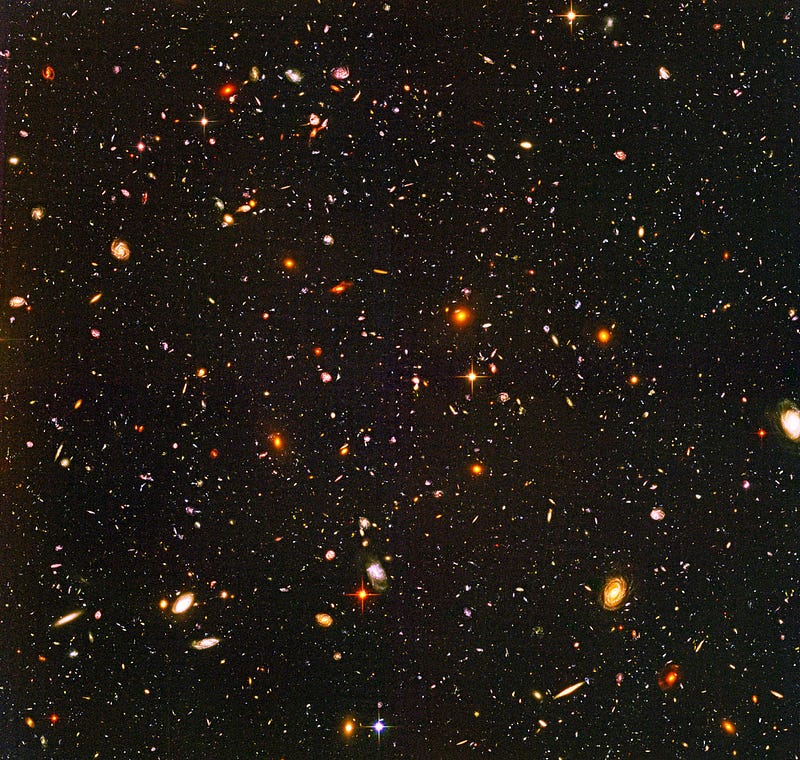
“Why should I care whether Dark Energy exists or whether it’s just an intellectual exercise????? aka ‘What’s in it for me?’” –Norma Parfit
See all those things in the night sky? Everything out beyond the stars in our own galaxy? In a few billion years, we’ll merge together with Andromeda, the only other large galaxy in our local group, and our combined, giant elliptical galaxy will eventually gobble up the modest Triangulum galaxy and then the remaining dwarf galaxies orbiting us, and then all we’ll have beyond our own galaxy is this: a blank, dark, intergalactic void. The above image, if I removed all the galaxies the same way dark energy will, will leave us with only the foreground stars of our own galaxy.

Because thanks to dark energy, all of this — every other galaxy, group, cluster, and supercluster of galaxies — will disappear from our observable Universe. That’s the inevitable fate of our entire Universe. So what’s in it for you? The opportunity to know the Universe, as it is right now, and as it won’t be in a trillion years.
In fact, if humans came on the scene, for the first time, a trillion years from now, we never would have learned about the cosmic microwave background, about distant galaxies, clusters, or have seen a single “spiral nebula” in the night sky. Because dark energy is going to accelerate thatall away. Even Virgo, the closest large collection of galaxies to us, will disappear from view.
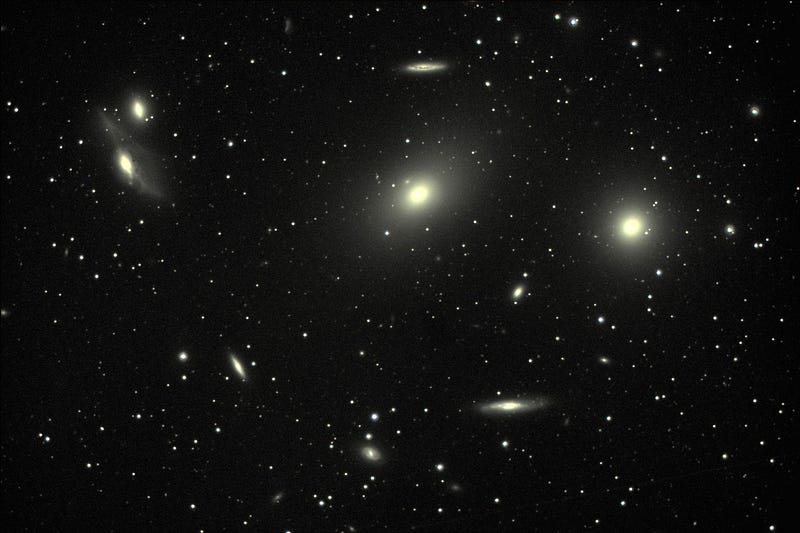
And if that doesn’t make you care, I don’t know what will. Even though I wish we understood its nature better, this is our Universe, full of dark energy, as we know it today. Enjoy it while it lasts, because it only gets lonelier from here!
An earlier version of this post originally appeared on the old Starts With A Bang blog at Scienceblogs.





